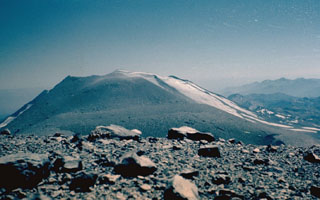Report on Nevados de Chillan (Chile) — 4 April-10 April 2018
Smithsonian Institution / US Geological Survey
Weekly Volcanic Activity Report, 4 April-10 April 2018
Managing Editor: Sally Sennert.
Please cite this report as:
Global Volcanism Program, 2018. Report on Nevados de Chillan (Chile) (Sennert, S, ed.). Weekly Volcanic Activity Report, 4 April-10 April 2018. Smithsonian Institution and US Geological Survey.
Nevados de Chillan
Chile
36.868°S, 71.378°W; summit elev. 3180 m
All times are local (unless otherwise noted)
Servicio Nacional de Geología and Minería (SERNAGEOMIN) Observatorio Volcanológico de Los Andes del Sur (OVDAS) reported continuing activity through 5 April associated with growth of the Gil-Cruz lava dome in Nevados de Chillán’s Nicanor Crater. During 16-31 March the seismic network recorded 44 volcano-tectonic events with maximum local magnitude (ML) of 2.6. In addition, there were 3,874 earthquakes associated with fluid movement; of those 2,645 earthquakes were long-period events. A total of 1,229 tremor events were also detected. Explosive events totaled 765, mainly accompanying magmatic gas emissions and/or acoustic signals recorded by microphones on the flanks. Acoustic pressure from explosions increased on 24 March, and culminated with two major explosions on 30 and 31 March exceeding pressures much higher than previously recorded since the emergence of the dome. Webcam images showed mainly gas emission from explosions, rising no higher than 2 km above the crater rim. Incandescence associated with some explosions was sporadically visible at night.
During an overflight on 3 April scientists observed intermittent whitish-to-grayish emissions rising from the SE-NW-trending fissure on the lava dome’s surface. They also noted lapilli deposits as far as 1 km. Even though subsidence in the central part of the dome was visible, the dome had grown compared to the last observation on 11 March. The dome had extended E to the edge of Nicanor Crater and rose higher than the crater rim, although was mostly circular. The maximum temperature of the dome surface was 670 degrees Celsius. The report noted that a decrease in daily seismic events (suggesting pressurization), two significant explosions, and the dome growing higher than the crater rim prompted OVDAS- SERNAGEOMIN to raise the Alert Level to Orange, the second highest level on a four-color scale. ONEMI maintained an Alert Level Yellow (the middle level on a three-color scale) for the communities of Pinto, Coihueco, and San Fabián.
Geological Summary. The compound volcano of Nevados de Chillán is one of the most active of the Central Andes. Three late-Pleistocene to Holocene stratovolcanoes were constructed along a NNW-SSE line within three nested Pleistocene calderas, which produced ignimbrite sheets extending more than 100 km into the Central Depression of Chile. The dominantly andesitic Cerro Blanco (Volcán Nevado) stratovolcano is located at the NW end of the massif. Volcán Viejo (Volcán Chillán), which was the main active vent during the 17th-19th centuries, occupies the SE end. The Volcán Nuevo lava-dome complex formed during 1906-1945 on the NW flank of Viejo. The Volcán Arrau dome complex was then constructed on the SE side of Volcán Nuevo between 1973 and 1986, and eventually exceeded its height. Smaller domes or cones are present in the 5-km valley between the two major edifices.
Sources: Servicio Nacional de Geología y Minería (SERNAGEOMIN), Oficina Nacional de Emergencia-Ministerio del Interior (ONEMI)

